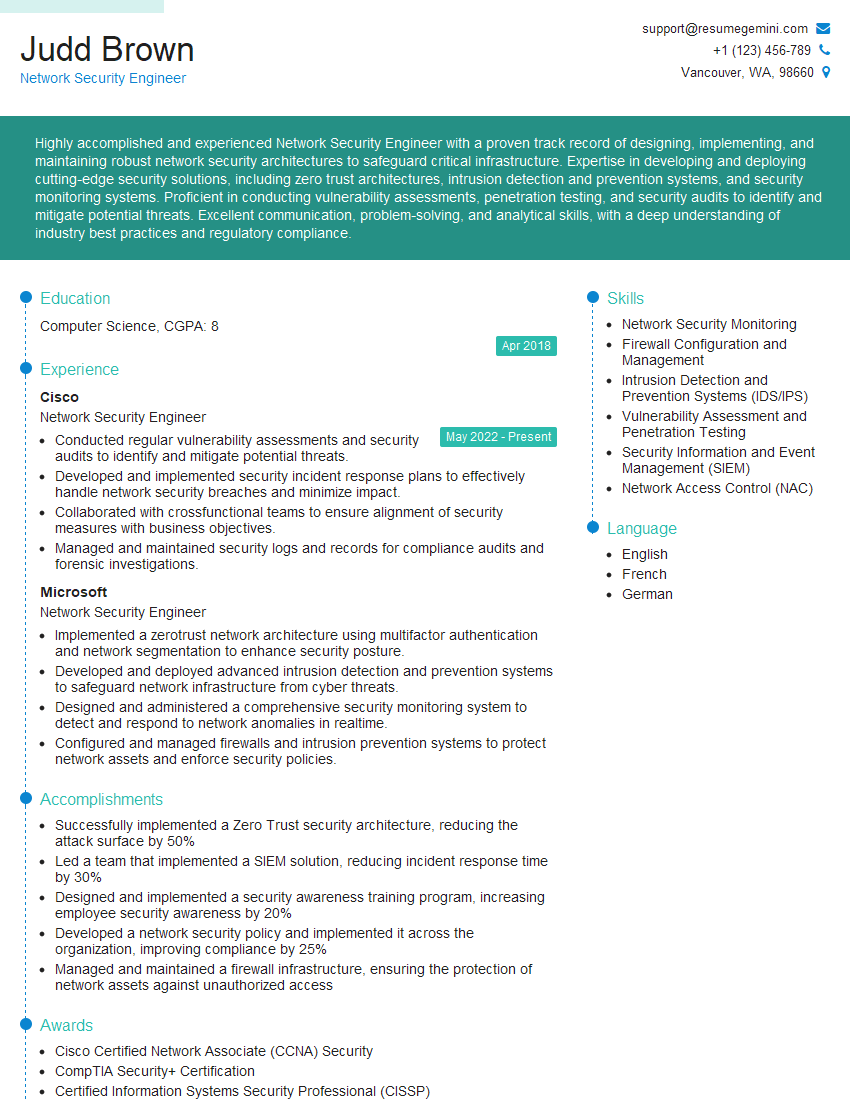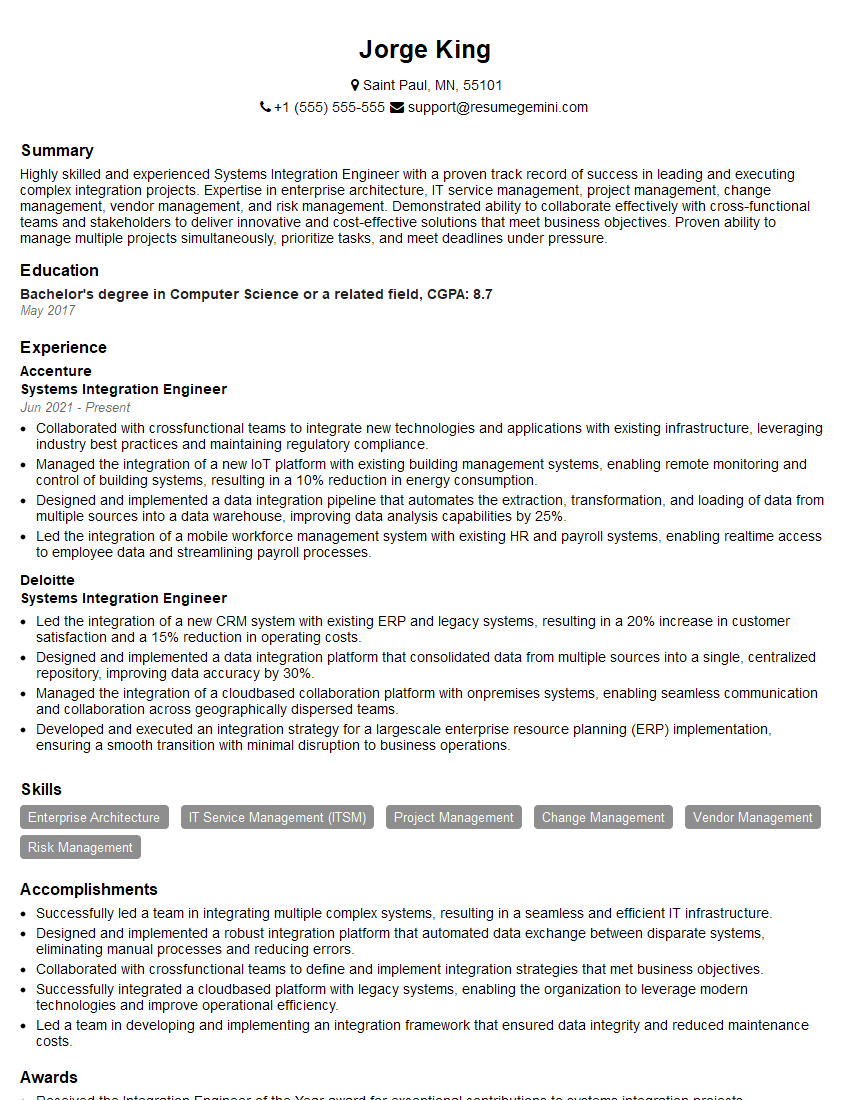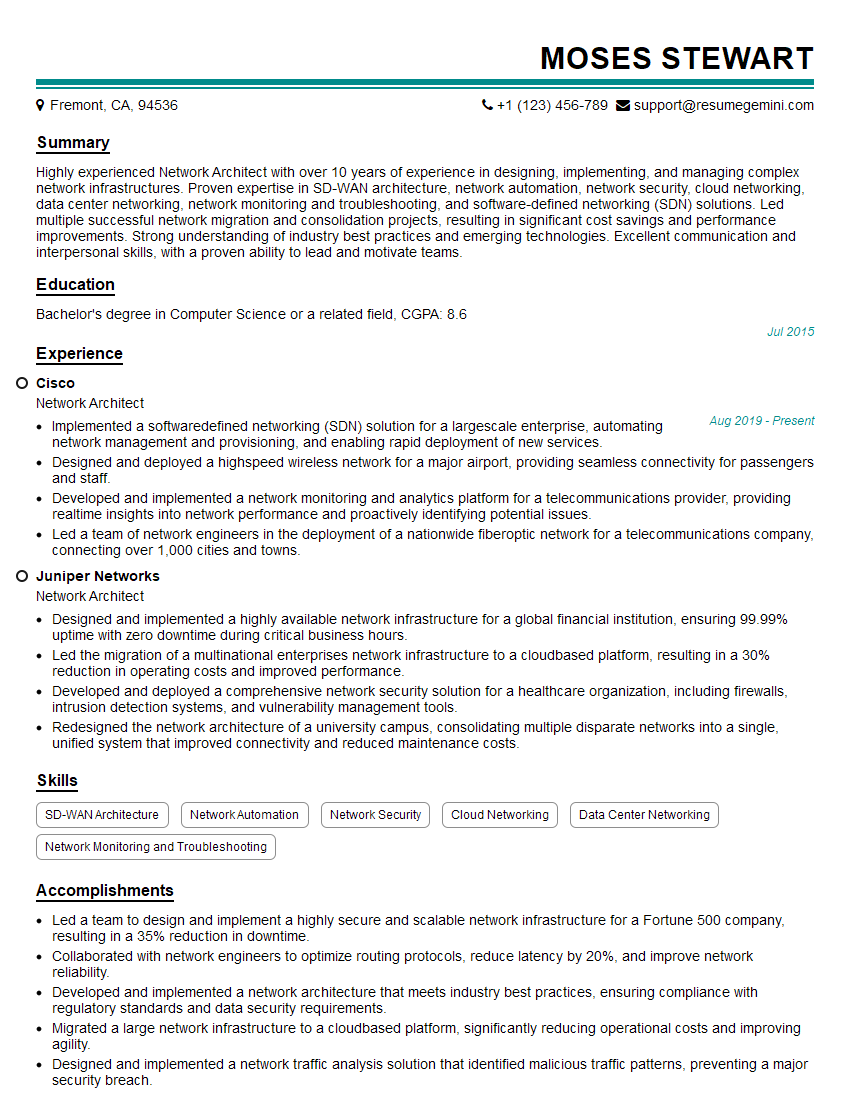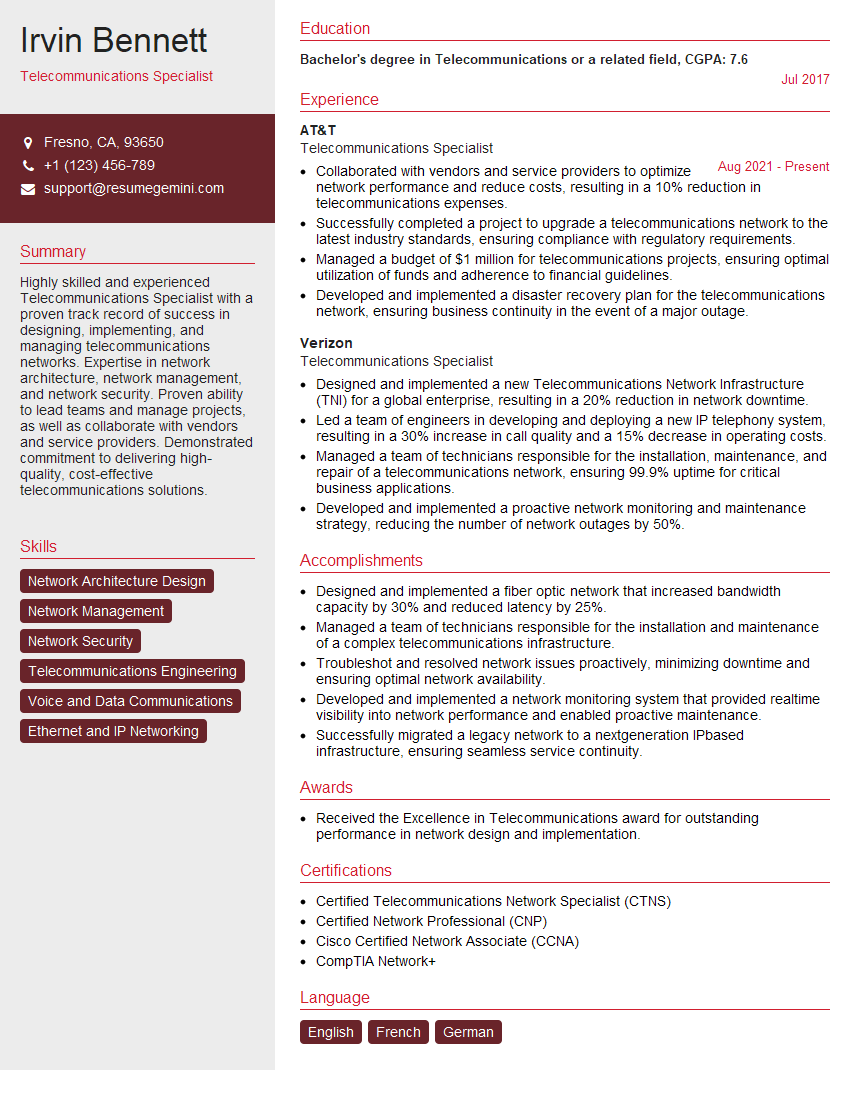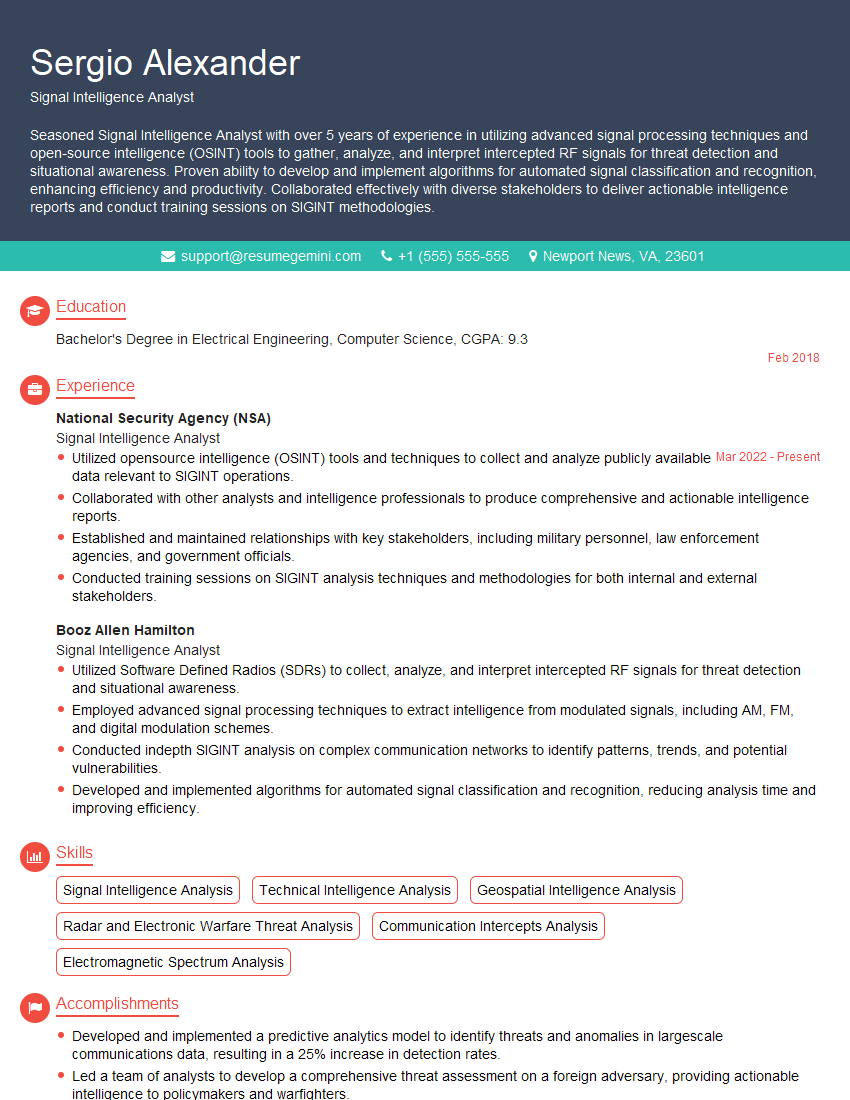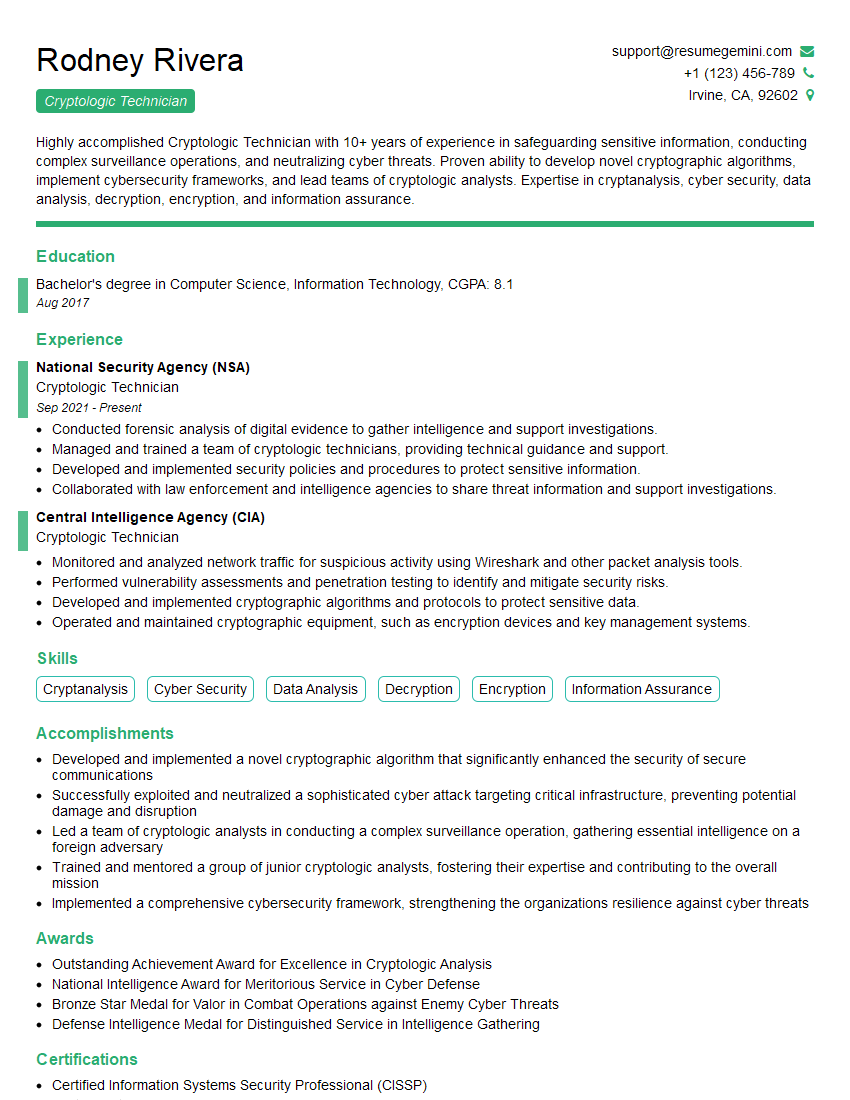The thought of an interview can be nerve-wracking, but the right preparation can make all the difference. Explore this comprehensive guide to Tactical Communications Systems interview questions and gain the confidence you need to showcase your abilities and secure the role.
Questions Asked in Tactical Communications Systems Interview
Q 1. Describe your experience with different types of tactical communication systems (e.g., VHF, UHF, HF, satellite).
My experience encompasses a wide range of tactical communication systems. I’ve worked extensively with VHF (Very High Frequency) systems, primarily for short-range, line-of-sight communications, often used in local coordination between units. UHF (Ultra High Frequency) systems offer slightly longer ranges and better penetration through obstacles than VHF, making them suitable for broader area communications. I’ve also worked with HF (High Frequency) systems, which leverage ionospheric reflection for long-range communication, crucial in scenarios with limited infrastructure, like over-the-horizon communication. Finally, my experience includes satellite communication systems, offering global reach and high bandwidth capabilities, invaluable for situations requiring extensive data transfer or communication across vast distances, but often demanding more specialized equipment and higher costs.
For instance, during a field exercise involving multiple teams dispersed across a large area, we relied on a combination of UHF radios for close-range communication and a satellite system for coordinating actions between dispersed teams and the central command. The VHF radios were utilized for short-range, immediate communication within each team.
Q 2. Explain the concept of frequency hopping spread spectrum and its advantages in tactical communications.
Frequency Hopping Spread Spectrum (FHSS) is a technique that enhances communication security and resilience by rapidly changing the radio frequency used for transmission. Instead of staying on one frequency, the system ‘hops’ across a predefined set of frequencies according to a pseudorandom sequence known only to the communicating parties. This makes it difficult for unauthorized listeners (jammers) to intercept the communication, as they’d have to constantly track the hopping frequency. Imagine a conversation happening in a crowded room; instead of speaking in a fixed spot, you move around randomly, making it much harder for others to eavesdrop.
The key advantages of FHSS in tactical communications are:
- Enhanced Security: Difficult for unauthorized interception.
- Resistance to jamming: Jammers need to track and jam multiple frequencies simultaneously.
- Improved anti-interference: Less susceptible to interference from other signals.
- Increased capacity: Multiple users can share the same frequency band without interference due to the frequency hopping.
FHSS is particularly useful in contested environments where communication security and reliability are paramount.
Q 3. What are the key security considerations in designing a tactical communications network?
Security in tactical communication network design is crucial. Key considerations include:
- Encryption: Employing strong encryption algorithms (e.g., AES) to protect data transmitted over the network from unauthorized access.
- Authentication: Verifying the identity of communicating parties to prevent impersonation attacks.
- Access Control: Restricting access to the network based on user roles and permissions.
- Data Integrity: Ensuring data hasn’t been tampered with during transmission using checksums or hashing algorithms.
- Physical Security: Protecting communication equipment from physical theft or damage.
- Network Security: Implementing firewalls and intrusion detection systems to prevent unauthorized access and cyberattacks.
- Frequency Management: Careful selection and management of communication frequencies to avoid interference and ensure security from frequency scanning.
Failure to address these aspects can lead to compromised operations, mission failure, and potentially loss of life.
Q 4. How do you ensure network reliability and redundancy in a tactical environment?
Network reliability and redundancy are critical in tactical environments where communication failures can have severe consequences. This is achieved through:
- Redundant Links: Establishing multiple communication paths between nodes. If one path fails, another can take over seamlessly. This might involve using different communication technologies (e.g., satellite and terrestrial links) or multiple paths within the same technology.
- Diverse Routing Protocols: Using protocols that can automatically adapt to changing network conditions and find alternative routes if a link fails.
- Network Management Systems: Employing tools to monitor network performance, detect failures, and automatically switch to backup systems.
- Robust Hardware: Using hardened equipment designed to withstand harsh environments and operate reliably under stressful conditions.
- Mesh Networks: Creating decentralized networks where each node can relay messages to others, increasing resilience to node failures.
For example, a military operation might use a combination of satellite, radio, and wired links to ensure communication continuity even if one link is damaged or jammed.
Q 5. Describe your experience with network protocols commonly used in tactical communications (e.g., TCP/IP, UDP).
I have extensive experience with network protocols used in tactical communications. TCP/IP (Transmission Control Protocol/Internet Protocol) is widely used for reliable data transfer, guaranteeing delivery and ordering of packets. However, its overhead can be significant, impacting performance in bandwidth-constrained environments. UDP (User Datagram Protocol) is a connectionless protocol that prioritizes speed and efficiency over reliability. It’s ideal for applications where occasional packet loss is acceptable, such as real-time voice or video streaming. The choice between TCP/IP and UDP depends on the specific application requirements. Real-time applications like video surveillance might utilize UDP for its low latency, while file transfers might benefit from TCP’s guaranteed delivery.
Other protocols I’m familiar with include those specifically designed for tactical networks, optimized for low bandwidth, high latency conditions, and often incorporate specialized security features.
Q 6. Explain your understanding of network topologies and their suitability for different tactical scenarios.
Network topologies define how nodes are connected in a network. Different topologies suit different tactical scenarios:
- Star Topology: All nodes connect to a central hub. Simple to manage but a single point of failure. Suitable for smaller, localized networks where a central command center is essential.
- Mesh Topology: Nodes connect to multiple other nodes, creating redundant paths. Highly resilient but complex to manage. Ideal for large, dispersed networks requiring high reliability.
- Bus Topology: All nodes connect to a single cable. Simple but vulnerable to failures in the main cable. Generally less suitable for tactical settings due to lack of resilience.
- Ring Topology: Nodes connect in a closed loop. Data flows in one direction. Relatively simple but can be affected by a single node failure.
The choice of topology depends on factors like network size, geographical distribution of nodes, required reliability, and management complexity. A large-scale military operation might use a mesh topology for robustness, while a smaller unit might use a star topology for simplicity.
Q 7. What are the challenges of integrating different communication systems in a tactical environment?
Integrating different communication systems in a tactical environment presents several challenges:
- Interoperability: Different systems may use incompatible protocols, frequencies, or data formats. This requires careful planning and the use of gateways or translators to enable communication between different systems.
- Security: Integrating various systems increases the attack surface and necessitates a comprehensive security architecture encompassing all systems.
- Bandwidth Management: Efficiently managing bandwidth across different systems with varying bandwidth requirements is crucial.
- Power Consumption: Balancing the power consumption of diverse systems with the available power sources is a significant concern in tactical settings.
- Size, Weight, and Power (SWaP): Integrating multiple systems can increase overall SWaP, which needs to be optimized for portability and usability.
- Cost: Integrating diverse systems requires investment in hardware, software, and training, adding up to substantial costs.
Overcoming these challenges requires a systematic approach involving careful planning, selection of compatible systems, and implementation of robust integration strategies.
Q 8. How do you troubleshoot connectivity issues in a tactical communications network?
Troubleshooting connectivity issues in a tactical communications network requires a systematic approach. Think of it like diagnosing a car problem – you need to check various systems to pinpoint the fault. I start by identifying the affected area and the type of communication failure. Is it a complete outage, intermittent connectivity, or low data rates? Then I proceed using a layered approach.
- Layer 1 (Physical): I check for physical damage to cables, antennas, and equipment. Loose connectors are a common culprit! I also verify power is reaching all devices. Imagine a soldier’s radio – a simple dead battery can cause a complete communication breakdown.
- Layer 2 (Data Link): Here I examine the network configuration, including MAC addresses and the network topology. Are there any bridging or switching issues? I use tools like network analyzers to pinpoint faulty connections or signal interference.
- Layer 3 (Network): At this layer, I verify IP addressing, routing, and subnet masks. Are there any IP address conflicts or routing problems? Ping tests and traceroutes are invaluable here. In a tactical environment, this might involve checking the network configuration of multiple vehicles coordinating an operation.
- Higher Layers: For application-level issues, I examine the specific applications used. Is there a problem with the software, or are there conflicting security settings? For example, a failure in encryption protocols could disrupt secure voice communication.
Throughout this process, thorough documentation is crucial. This helps me track my progress and enables efficient collaboration with other team members. In a real-world scenario during a field exercise, for example, I’d use a combination of diagnostic tools and my experience to quickly isolate and resolve the issue, ensuring critical communications remain operational.
Q 9. Describe your experience with cryptographic systems used in securing tactical communications.
My experience with cryptographic systems in tactical communications is extensive. I’ve worked with a range of encryption algorithms, from symmetric key systems like AES (Advanced Encryption Standard) to asymmetric key systems such as RSA (Rivest–Shamir–Adleman). The choice of algorithm depends heavily on the sensitivity of the data and the operational constraints. In high-bandwidth scenarios, symmetric encryption is preferred for speed, while asymmetric encryption is often used for key exchange and digital signatures because of its inherent security features.
I’m familiar with various cryptographic protocols, including those implementing VPNs (Virtual Private Networks) to secure communications over insecure networks. For example, I’ve deployed and managed IPsec (Internet Protocol Security) and have experience integrating encryption capabilities into tactical radios and data links. A critical element is key management— ensuring keys are securely generated, distributed, and managed throughout their lifecycle, including securely destroying them when no longer needed. This is crucial in preventing breaches of security. Failure to do so could have severe consequences in a tactical environment.
Furthermore, I understand the importance of adhering to relevant security standards and best practices to ensure interoperability and compliance. In short, my experience spans both the theoretical understanding and practical implementation of robust cryptographic systems for protecting sensitive tactical communications data.
Q 10. What are the key performance indicators (KPIs) you would monitor in a tactical communications network?
Key Performance Indicators (KPIs) in a tactical communications network are crucial for monitoring performance, identifying bottlenecks, and ensuring the network remains reliable and efficient. They can be broadly categorized:
- Availability: This measures the percentage of time the network is operational. In a tactical environment, high availability is paramount. Downtime translates directly to compromised operational effectiveness.
- Latency: This measures the delay in communication. High latency can be disastrous in time-sensitive tactical situations. Think about the delay in transmitting crucial targeting data.
- Throughput: This measures the amount of data transmitted per unit of time. Sufficient throughput is crucial to support various applications like video conferencing, data transfer, and voice communication simultaneously.
- Packet Loss: This refers to the percentage of data packets that don’t reach their destination. High packet loss indicates serious network problems needing immediate attention.
- Jitter: This measures the variation in latency. High jitter can affect the quality of real-time communication, for instance, voice clarity.
- Signal Strength and Quality: These are especially important in tactical environments where signal conditions can be challenging. Poor signal strength can lead to connectivity problems.
I routinely use network monitoring tools to collect and analyze these KPIs. Real-time dashboards provide an immediate overview, while historical data allows for trend analysis, enabling proactive maintenance and problem prevention. The specific KPIs prioritized will change depending on the tactical mission.
Q 11. Explain your experience with different types of antennas and their applications in tactical communications.
My experience encompasses a wide range of antennas used in tactical communications, each with its own strengths and weaknesses. The selection of an antenna depends significantly on the frequency band, environment, and required performance.
- Whip Antennas: These are simple, compact, and relatively inexpensive. They’re suitable for handheld radios and are commonly used for short-range communication, but their performance can be less than ideal in complex environments.
- Helical Antennas: These are effective for very high frequency (VHF) and ultra-high frequency (UHF) communications and are often found on military vehicles because of their circular polarization and relatively wide bandwidth.
- Yagi Antennas: These directional antennas provide high gain and are well-suited for long-range point-to-point communication. However, they need to be carefully aimed and lack omnidirectional coverage.
- Panel Antennas: These planar antennas often offer a good compromise between gain, size, and beamwidth. They are frequently used in vehicular and fixed installations.
- Satellite Antennas: These antennas are used for satellite communication, providing long-range connectivity even in remote areas. However, they require precise alignment and often involve more complex equipment.
In tactical settings, antenna selection is a critical decision. I’ve been involved in selecting and deploying antennas for various scenarios – from handheld radios for infantry to sophisticated antenna systems on command and control vehicles. My knowledge of antenna patterns, gain, and impedance matching is paramount to ensuring effective communication.
Q 12. Describe your understanding of RF propagation and its impact on tactical communications.
RF propagation, the behavior of radio waves as they travel through space, significantly impacts tactical communications. Understanding it is essential for designing and operating effective communication systems. Think of it like throwing a ball – different environments affect how far and how accurately it travels.
Several factors influence RF propagation:
- Frequency: Higher frequencies generally have shorter wavelengths and are more susceptible to attenuation and absorption by obstacles. Lower frequencies, conversely, can penetrate obstacles more easily but suffer from diffraction.
- Terrain: Hills, buildings, and vegetation can block, reflect, or diffract radio waves, causing signal fading or shadow zones. This is particularly challenging in urban or mountainous terrains.
- Atmospheric Conditions: Temperature, humidity, and precipitation can affect the propagation of radio waves. Rain, for example, can significantly attenuate high-frequency signals.
- Multipath Propagation: Signals can travel multiple paths, reaching the receiver at slightly different times. This can lead to interference and signal degradation.
In tactical communications, we mitigate the negative impacts of RF propagation through careful antenna placement, selection of appropriate frequencies, and the use of techniques like frequency hopping and diversity reception. My experience involves using propagation models and simulation software to predict signal coverage and optimize system performance, thereby ensuring reliable communication in challenging environments.
Q 13. How do you manage spectrum allocation in a tactical communications environment?
Spectrum allocation in a tactical communications environment is a complex undertaking requiring careful planning and coordination. It’s like managing a busy highway – you need to ensure all users have access to the necessary lanes (frequencies) without causing congestion or collisions (interference).
The process involves:
- Identifying communication needs: This includes determining the number of users, types of communication (voice, data, video), and required bandwidth.
- Frequency selection: Selecting appropriate frequencies that are available and minimize interference. This frequently involves coordination with regulatory bodies and other users of the radio spectrum.
- Frequency assignment: Assigning specific frequencies to different users or systems, ensuring efficient utilization of the available spectrum. This often involves using frequency coordination software and adhering to strict guidelines to avoid interference.
- Monitoring and adjustment: Continuously monitoring the spectrum usage to detect and resolve interference issues. Dynamic frequency allocation is often used in complex environments to optimize spectrum usage in real-time.
In practice, this often means working with spectrum management tools and coordinating with other units and organizations to ensure efficient and interference-free communication. This is critical in a combined operations environment where different forces might be using the same frequency bands.
Q 14. Explain your experience with power management techniques in tactical communications.
Power management is crucial in tactical communications, especially in battery-powered devices operating in remote areas. It’s like managing the fuel in a vehicle – you need to optimize consumption for maximum range and operational time.
My experience with power management techniques includes:
- Power-saving modes: Utilizing low-power modes when communication is not actively required. This is often controlled by software and can significantly extend battery life.
- Adaptive power control: Adjusting the transmit power based on the distance to the receiver. This avoids unnecessary power consumption and minimizes interference to other users.
- Energy harvesting techniques: Exploring techniques such as solar panels or vibration energy harvesters to supplement battery power in situations with limited access to traditional power sources.
- Efficient hardware selection: Choosing low-power components and circuits in the design of communication equipment. This includes selecting efficient amplifiers and power regulators.
- Smart battery management systems: Using systems that monitor battery voltage and current to optimize charging and discharge cycles, extending the lifespan of batteries.
Effective power management maximizes operational time and increases the overall effectiveness of tactical communications systems, especially in scenarios where resupply or access to traditional power sources are limited or impossible.
Q 15. What are the limitations of using commercial off-the-shelf (COTS) equipment in tactical applications?
While Commercial Off-The-Shelf (COTS) equipment offers cost-effectiveness and readily available technology, using it in tactical applications presents several limitations. The primary concern is often a lack of robustness and reliability needed in harsh environments. COTS devices are typically designed for commercial use, prioritizing features like ease of use and cost over extreme durability and resistance to environmental factors like extreme temperatures, dust, and vibrations. This can lead to equipment failure in the field, impacting mission success.
Secondly, security is a major issue. COTS equipment may not incorporate the same level of security features as purpose-built military-grade systems. This makes them vulnerable to cyberattacks and data breaches, which is unacceptable in a tactical environment where sensitive information is exchanged.
Interoperability can also be a challenge. Different COTS systems might use incompatible protocols or lack standardized interfaces, hindering seamless communication between units and platforms. Finally, lifecycle management can be problematic. COTS products often have shorter lifespans and may not receive timely security updates or support, creating vulnerabilities over time.
For example, imagine a team using COTS radios in a desert environment. Sand could easily damage the radios, disrupting communication. Or, a system lacking proper encryption could be compromised by an adversary, revealing sensitive location data.
Career Expert Tips:
- Ace those interviews! Prepare effectively by reviewing the Top 50 Most Common Interview Questions on ResumeGemini.
- Navigate your job search with confidence! Explore a wide range of Career Tips on ResumeGemini. Learn about common challenges and recommendations to overcome them.
- Craft the perfect resume! Master the Art of Resume Writing with ResumeGemini’s guide. Showcase your unique qualifications and achievements effectively.
- Don’t miss out on holiday savings! Build your dream resume with ResumeGemini’s ATS optimized templates.
Q 16. How do you ensure interoperability between different communication systems?
Ensuring interoperability between different communication systems requires a multi-faceted approach. At the core is the use of standardized protocols and interfaces. This allows different systems from various vendors to communicate seamlessly. Examples include the use of Joint Tactical Radio System (JTRS) standards and other military-specific protocols.
Network architecture plays a crucial role. A well-designed network that incorporates gateways and translators can connect disparate systems even if they use different protocols. This involves careful planning and selection of equipment that supports the desired interoperability. Regular interoperability testing is essential. This involves testing communication between different systems under various conditions to identify and address any compatibility issues before deployment.
Furthermore, employing common data formats and encoding schemes reduces compatibility challenges. Finally, robust network management systems capable of monitoring and controlling the entire network are vital for detecting and resolving interoperability problems in real-time.
Imagine a scenario with soldiers using radios from different manufacturers. If those radios adhere to the same standards, they can easily communicate, even if the software or hardware differs significantly. Proper interoperability testing before deployment can prevent failures in critical moments.
Q 17. Describe your experience with network monitoring and management tools.
My experience with network monitoring and management tools is extensive, encompassing both commercial and specialized military-grade systems. I’m proficient in using tools like SolarWinds, PRTG Network Monitor, and specialized military network management systems. These tools allow for real-time monitoring of network performance, identifying bottlenecks and potential issues before they impact operations.
I’m skilled in analyzing network traffic patterns to identify anomalies, which could indicate intrusions or malfunctions. I use these tools to generate reports to track network health, identify trends, and plan for future capacity expansion. My experience extends to using tools for remote network management, enabling proactive maintenance and troubleshooting of systems in geographically dispersed locations, a critical aspect of tactical communications.
For instance, I’ve used SolarWinds to monitor the performance of a large tactical network, identifying a bandwidth bottleneck that was significantly affecting data transfer speeds. By identifying the problem quickly through the network monitoring tools, we averted a major communications disruption during a critical mission.
Q 18. Explain your understanding of cybersecurity threats and vulnerabilities in tactical communications.
Tactical communications networks face a multitude of cybersecurity threats and vulnerabilities. Denial-of-service (DoS) attacks can overwhelm the network, disrupting communication. Man-in-the-middle (MitM) attacks can intercept and alter communications, compromising data integrity and confidentiality. Malware can infect devices, granting attackers unauthorized access and control.
Insider threats, from disgruntled personnel or compromised accounts, are also a major risk. Weak security configurations, such as default passwords and unpatched software, leave systems vulnerable to exploitation. Physical security breaches, such as unauthorized access to equipment, can provide attackers with direct access to the network. Finally, the use of unsecured wireless networks increases the risk of interception and unauthorized access.
In a tactical setting, these vulnerabilities can have severe consequences, such as the loss of situational awareness, compromised mission plans, or even the loss of life.
Q 19. How do you mitigate cybersecurity risks in a tactical communications network?
Mitigating cybersecurity risks in a tactical communications network requires a layered approach. Network segmentation isolates critical systems from less secure ones, limiting the impact of a breach. Strong authentication and authorization mechanisms, such as multi-factor authentication and role-based access control, prevent unauthorized access.
Regular security patching and updates are essential to address known vulnerabilities. Intrusion detection and prevention systems (IDPS) actively monitor network traffic for malicious activity, alerting administrators to potential threats. Data encryption protects sensitive data from unauthorized access, even if a breach occurs. Security awareness training for personnel is crucial to reduce the risk of human error.
Regular security audits and penetration testing identify weaknesses and vulnerabilities in the system. Finally, having a comprehensive incident response plan is essential for quickly addressing and containing security incidents.
For example, implementing strong passwords and multi-factor authentication drastically reduces the risk of unauthorized access. Regularly patching software prevents attackers from exploiting known vulnerabilities.
Q 20. Describe your experience with incident response in a tactical communications environment.
My experience with incident response in a tactical communications environment includes leading and participating in numerous exercises and real-world incident responses. My approach follows a structured methodology that emphasizes rapid containment, investigation, and recovery. This includes establishing a dedicated incident response team, securing the affected systems, and isolating them from the rest of the network.
I’m proficient in using forensic tools to analyze network logs and system data to identify the root cause of the incident. I collaborate with other teams to develop and implement remediation strategies, which can include restoring systems from backups, patching vulnerabilities, and implementing stronger security controls.
Post-incident activities include conducting thorough analysis to identify the weaknesses that allowed the incident to occur, and recommending changes to prevent similar incidents in the future. Documentation and reporting are also critical aspects of incident response, ensuring lessons learned are captured and shared.
For instance, during a simulated cyberattack, I led the incident response team in isolating the compromised system, containing the breach, and restoring network functionality within a few hours. The post-incident analysis led to improved security protocols, enhancing the overall security posture of the network.
Q 21. What are the ethical considerations involved in using tactical communications systems?
Ethical considerations in using tactical communications systems are paramount. Privacy is a major concern. Systems should be designed and used to minimize the collection and retention of personal data, adhering to relevant privacy regulations and policies. Data security is equally crucial. The confidentiality, integrity, and availability of data must be protected through appropriate security measures, mitigating the risks of unauthorized access or disclosure. Transparency and accountability in the use of tactical communication systems are vital. Clear policies and procedures should govern the use of such systems, ensuring they are utilized responsibly and ethically.
Additionally, there are ethical implications related to the use of these systems in conflict zones or sensitive operations. This includes considering the potential impact on civilians and adhering to international humanitarian law. The use of surveillance technologies within these systems raises concerns about potential abuses and infringements on individual rights. Finally, maintaining professionalism and integrity in all communications is critical.
For example, ensuring that only necessary data is collected and retained, and then securely destroyed once it is no longer required, is crucial for upholding ethical standards. Similarly, adhering to strict regulations regarding the interception and monitoring of communications ensures respect for privacy rights.
Q 22. Explain your experience with system design and implementation in a tactical environment.
My experience in tactical communications system design and implementation spans over 10 years, encompassing various challenging environments. I’ve been involved in the entire lifecycle, from initial requirements gathering and system architecture design to deployment and post-implementation support. For instance, I led the design and implementation of a resilient mesh network for a large-scale military exercise. This involved selecting appropriate radios (considering factors like range, power consumption, and security), designing robust routing protocols to handle network failures, and integrating with existing command and control systems. We successfully achieved seamless communication despite significant terrain challenges and simulated enemy jamming.
Another project focused on integrating commercial off-the-shelf (COTS) technologies into a tactical network. This required careful selection and integration to ensure interoperability and security. We developed customized software to bridge communication gaps between different system types, resulting in a more unified and efficient communication infrastructure. This project highlighted the importance of understanding both the technical limitations and opportunities offered by different technologies.
- System Architecture Design: Experience with various network topologies (mesh, star, bus) and protocol selection (e.g., TCP/IP, UDP).
- Integration: Successfully integrated various COTS and custom-built components into cohesive systems.
- Deployment and Support: Provided on-site support for deployments in challenging terrains, addressing connectivity issues and providing training to end-users.
Q 23. How do you stay current with the latest advancements in tactical communications technology?
Staying abreast of the rapidly evolving tactical communications landscape is crucial. I actively participate in industry conferences like AFCEA (Armed Forces Communications and Electronics Association) and attend relevant webinars and online courses. I subscribe to industry publications like Signal Magazine and regularly review technical journals such as IEEE Communications Magazine to stay updated on new technologies and trends. I also maintain professional relationships with leading vendors and researchers in the field, frequently engaging in discussions about emerging technologies like software-defined radios (SDRs), artificial intelligence (AI) applications in communications, and quantum-resistant cryptography.
Furthermore, I leverage online resources such as arXiv and research databases to access the latest research papers and keep myself informed about cutting-edge developments. Hands-on experience through pilot projects and experimenting with new technologies in controlled environments is also vital for practical understanding. It’s not just about reading about the advancements but also understanding their practical implications and limitations within the constraints of a tactical environment.
Q 24. Describe your experience working in a team environment in a high-pressure situation.
Teamwork is essential in the high-pressure environment of tactical communications. I’ve consistently demonstrated my ability to collaborate effectively under pressure, both as a team leader and a team member. During a deployment for a critical national security exercise, our team faced a major network outage just hours before the commencement of the exercise. Instead of panicking, we followed a structured approach, rapidly dividing tasks based on each member’s expertise. I coordinated communication between the different sub-teams while simultaneously troubleshooting the network issue. Through effective communication and collaborative problem-solving, we successfully restored the network within the critical timeframe. This experience demonstrated the value of clear communication, mutual trust and well-defined roles in a high-pressure environment.
This experience solidified my understanding of the importance of clear and concise communication, active listening, and the ability to delegate tasks effectively. The ability to motivate team members and foster a supportive environment under pressure is as crucial as the technical expertise itself.
Q 25. Explain your problem-solving approach when dealing with complex technical issues.
My problem-solving approach for complex technical issues follows a structured methodology. First, I thoroughly analyze the problem, identifying its root cause using a combination of diagnostic tools and logical deduction. For example, when dealing with intermittent network connectivity, I would first examine the signal strength, radio configurations, and environmental factors that could be affecting the link. After identifying the root cause, I develop a range of potential solutions, weighing their feasibility, cost, and risk implications. I then implement the most promising solution and carefully monitor its effectiveness.
Documentation is a key part of my approach. I ensure all findings, solutions, and lessons learned are documented to facilitate future troubleshooting and improve the system’s overall resilience. For instance, if a software bug is identified and resolved, I document the details of the bug, its cause, the fix implemented, and any other relevant information. This detailed documentation significantly streamlines future problem-solving and ensures that the knowledge gained remains accessible to the team.
Q 26. How do you handle conflicting priorities in a fast-paced tactical environment?
Conflicting priorities are common in the fast-paced world of tactical communications. My approach involves prioritizing tasks based on their impact and urgency, using a matrix that weighs both factors. High-impact, high-urgency tasks receive immediate attention, while low-impact, low-urgency tasks can be deferred. For tasks with conflicting priorities, I engage in open communication with stakeholders, clearly outlining the trade-offs involved and seeking consensus on the optimal approach. This often involves negotiating deadlines and adjusting expectations to ensure that the most critical needs are met effectively.
For example, if I had to address both a critical network security vulnerability and a less urgent system upgrade, I would immediately prioritize the security vulnerability, notifying the appropriate stakeholders about potential disruptions due to the delayed upgrade. Transparent communication is key to managing expectations and maintaining team morale during times of conflicting priorities.
Q 27. What are your salary expectations for this role?
Based on my experience and the requirements of this role, my salary expectations are in the range of $120,000 to $150,000 per year. This is commensurate with my skills and expertise in tactical communications systems, and reflects my contributions to previous projects.
Q 28. Do you have any questions for me?
I have several questions regarding this role. First, could you elaborate on the specific technologies and systems used by your team? Second, what are the opportunities for professional development and advancement within the company? Finally, what is the team’s current focus in terms of ongoing projects and future initiatives?
Key Topics to Learn for Tactical Communications Systems Interview
- Network Topologies and Protocols: Understanding mesh, star, and other network architectures crucial for tactical environments, along with relevant protocols like TCP/IP, VoIP, and specialized military protocols. Consider the strengths and weaknesses of each in a tactical context.
- RF Communication Principles: Grasping fundamental concepts like frequency bands, signal propagation, antenna theory, and interference mitigation is essential for optimizing communication performance in challenging environments.
- Security and Encryption: Familiarity with encryption methods, cybersecurity protocols, and techniques to protect sensitive data transmitted over tactical communication networks is critical. Explore data integrity and authentication methods.
- Interoperability and Standardization: Understanding the challenges and solutions related to integrating diverse communication systems from different manufacturers and achieving seamless data exchange across platforms is vital.
- System Integration and Troubleshooting: Practical experience or theoretical knowledge of installing, configuring, and troubleshooting tactical communication systems. Be prepared to discuss real-world scenarios and problem-solving approaches.
- Power Management and Resource Optimization: In tactical settings, efficient power management is key. Understanding techniques for optimizing power consumption and resource allocation in communication systems is valuable.
- Emerging Technologies: Staying up-to-date on advancements such as Software Defined Radio (SDR), satellite communication, and network virtualization within the tactical communications space demonstrates forward-thinking.
Next Steps
Mastering Tactical Communications Systems opens doors to exciting and impactful career opportunities in defense, public safety, and other critical sectors. To maximize your job prospects, it’s vital to present your skills and experience effectively. Creating an Applicant Tracking System (ATS)-friendly resume is crucial for getting your application noticed. ResumeGemini is a trusted resource that can help you build a professional, impactful resume tailored to highlight your expertise in Tactical Communications Systems. Examples of resumes specifically designed for this field are available to guide you.
Explore more articles
Users Rating of Our Blogs
Share Your Experience
We value your feedback! Please rate our content and share your thoughts (optional).
What Readers Say About Our Blog
Hello,
We found issues with your domain’s email setup that may be sending your messages to spam or blocking them completely. InboxShield Mini shows you how to fix it in minutes — no tech skills required.
Scan your domain now for details: https://inboxshield-mini.com/
— Adam @ InboxShield Mini
Reply STOP to unsubscribe
Hi, are you owner of interviewgemini.com? What if I told you I could help you find extra time in your schedule, reconnect with leads you didn’t even realize you missed, and bring in more “I want to work with you” conversations, without increasing your ad spend or hiring a full-time employee?
All with a flexible, budget-friendly service that could easily pay for itself. Sounds good?
Would it be nice to jump on a quick 10-minute call so I can show you exactly how we make this work?
Best,
Hapei
Marketing Director
Hey, I know you’re the owner of interviewgemini.com. I’ll be quick.
Fundraising for your business is tough and time-consuming. We make it easier by guaranteeing two private investor meetings each month, for six months. No demos, no pitch events – just direct introductions to active investors matched to your startup.
If youR17;re raising, this could help you build real momentum. Want me to send more info?
Hi, I represent an SEO company that specialises in getting you AI citations and higher rankings on Google. I’d like to offer you a 100% free SEO audit for your website. Would you be interested?
Hi, I represent an SEO company that specialises in getting you AI citations and higher rankings on Google. I’d like to offer you a 100% free SEO audit for your website. Would you be interested?
good
